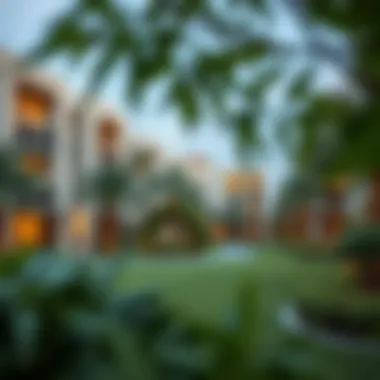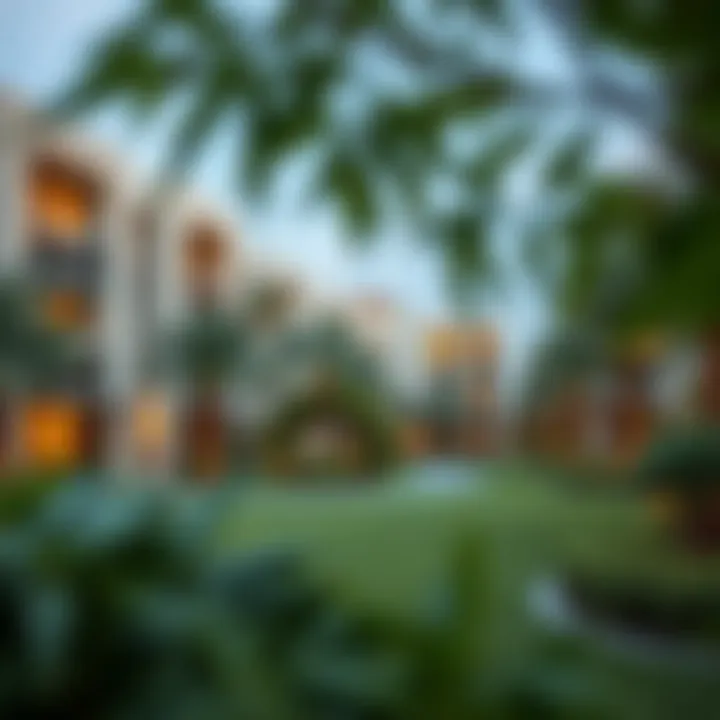Understanding the Six Senses in Dubai's Real Estate


Intro
In the shimmering oasis of Dubai, where tradition echoes amidst towering skyscrapers and the aroma of spices wafts through luxury malls, the concept of the Six Senses experience takes on a profound significance. This vibrant metropolis is more than just a hub for tourism; it is a living canvas where sensory experiences intersect with real estate dynamics. The blend of sights, sounds, tastes, touches, and smells plays a crucial role in how residents and investors perceive value in their surroundings.
By examining the nuances of the Six Senses, one can unearth intricate layers that define community living and property investments in this city. Investors, homeowners, and renters alike should consider how these sensory perceptions impact their choices and experiences in Dubai's ever-evolving real estate landscape.
As we navigate through the realm of sight, sound, taste, touch, and smell, it's essential to highlight how these senses inform real estate trends and the broader lifestyle in this cosmopolitan hub. This article aims to provide a comprehensive look at these intersections, ensuring that readers gain valuable insights into understanding and capitalizing on the unique offerings of Dubai's property market.
Prelims to the Six Senses in Dubai
Understanding the Six Senses framework is becoming increasingly vital in the context of Dubai’s ever-evolving real estate landscape. As the city continues to grow, developers and investors are finding that creating environments which engage all six senses can enhance the living experience, boost property values, and foster a more connected community. When we discuss the Six Senses—sight, sound, touch, smell, taste, and emotion—we delve into how these elements not only shape the physical space but also influence the emotional well-being of its inhabitants.
Defining the Six Senses
The concept of the Six Senses goes beyond just physical perceptions. Each sense weaves into the fabric of our daily experiences. For instance, sight isn’t merely about how a building looks; it’s about how it fits into the skyline, its architectural flow, and how light interacts with its surfaces throughout the day. Similarly, sound isn’t just the absence of noise, it’s the soundscape—can one hear the gentle rustle of palm fronds, or the distant melody of a traditional musician?
The Various Elements:
- Sight: The aesthetic appeal and visual harmony of structures.
- Sound: The auditory ambience created by both natural and artificial elements.
- Touch: The textures of materials used in design, ensuring comfortable and inviting spaces.
- Smell: The fragrances permeating the spaces, like those from gardens and markets.
- Taste: The culinary offerings available within the community.
- Emotion: The feelings evoked by experiences in these environments, shaping how people feel about where they live.
This definition captures the breadth and depth of sensory engagement in urban planning, highlighting how a holistic view enriches the user experience.
Importance of Sensory Awareness in Real Estate
When discussing real estate, sensory awareness isn’t merely a stylistic addition. It can serve as a primary driver in property decision-making for investors, developers, and homeowners alike. In Dubai, where competition runs high, those who can tap into the sensory dimensions of living spaces can create distinct advantages.
- Attracting Buyers: Properties that stimulate the senses often capture attention quicker. Think of a luxury apartment whose lobby resonates with soothing sounds, fragrant flowers, and lush greenery—it’s more than just a visual.
- Community Engagement: A well-designed community that focuses on sensory elements fosters connections among residents. Walking paths that delight the senses encourage outdoor activities, bringing neighbors together.
- Long-term Value: Properties that integrate sensory experiences are likely to retain higher value over time. Buyers today not only seek a house to live in but a home that resonates with their lifestyle, echoing positive memories and emotional responses.
"Creating environments that resonate emotionally and sensorially is no longer optional; it’s a requisite for future developments."
Incorporating these aspects into Dubai’s real estate is not just about keeping up with trends; it’s about paving the way for innovative living standards. By focusing on the Six Senses, stakeholders can redefine urban living, benefitting not only individual properties but also enhancing the vibrancy of the entire community.
The journey into the Six Senses experience in Dubai is not just an exploration of physical spaces, but also a quest into how these spaces influence human experiences, interactions, and ultimately, the quality of life. As we delve deeper into each of these sensory elements throughout the article, we will uncover how they contribute to a richer and more immersive living experience.
The Visual Appeal of Dubai
The visual landscape of Dubai is nothing short of a spectacle, a product of visionary architecture and forward-thinking urban planning. The relevance of this topic extends beyond mere aesthetics; it reflects the identity and character of the city, shaping its real estate market. Investors and homeowners alike find that properties which boast stunning views or are nestled within visually captivating surroundings often command higher value. The interplay of light, structure, and natural elements fosters a sense of place that can significantly enhance the living experience.
In Dubai, the visual appeal manifests through various elements that cater to both emotional and functional needs:
- Iconic Skyline: The skyline is continually evolving, marked by iconic structures such as the Burj Khalifa, which dominates with its audacious height and intricate design. Each building contributes a note to the city’s symphony, offering both challenges and opportunities for real estate developers.
- Neighborhood Integrity: Effective urban design ensures that the visual aesthetic matches the community’s needs. This creates harmony and encourages investment by enhancing the perceptions of neighborhoods.
- Cultural Interpretation: Visual elements often embody local heritage. This connection can be appealing to buyers who seek a cultural narrative in their housing, bridging the old and the new effectively.
Engaging with the visual appeal of Dubai is essential for those who want to navigate the city’s real estate landscape productively. The visual appeal can elevate one’s experience; it encourages individuals to explore the built environment with a critical eye, influencing their choices dramatically.
Architectural Marvels
Dubai’s architectural marvels are a testimony to human ingenuity and ambition. The city is a canvas where the future meets tradition, and each structure narrates a story of advancement.
Among these marvels, the Burj Khalifa stands out remarkably. Towering at 828 meters, it isn't just the tallest building; it symbolizes the aspirational ethos of the city. This architectural wonder attracts millions of tourists and property investors, as it sets a standard that many developments strive to emulate.
Additionally, The Louvre Abu Dhabi—a short drive from Dubai—blends culture and architecture harmoniously, showcasing how modern design can coexist with historical narratives. Such developments emphasize the importance of having a robust architectural identity.
- Challenges of Design: Building in Dubai comes with the challenge of creating visually stunning structures while addressing environmental issues, such as sustainable energy usage and heat management.
- Cultural Sensitivity: Successful structures pay homage to local culture and heritage, striking a balance between modernity and tradition.
Architectural marvels, therefore, become vital in attracting international attention, amplifying the desirability of real estate investments. They encapsulate the unique essence of Dubai, making it a global hub of innovation and culture.
The Role of Landscaping
Landscaping is often an overlooked aspect of the urban fabric, yet in Dubai, it plays a pivotal role in enhancing the visual narrative and offering sensory experiences that ground the city in nature. Not only does it improve the aesthetic appeal, but effective landscaping also increases property values and promotes well-being.
- Integration with Architecture: Thoughtful landscaping complements architectural designs, creating synergies that enhance livability. For instance, communities like Dubai Marina boast beautifully landscaped promenades that provide residents with leisure spaces and engaging environments.
- Creation of Green Spaces: The Dubai Miracle Garden epitomizes how extensive landscaping can transform spaces into lush havens, attracting visitors and enhancing real estate appeal in its vicinity.
- Environmental Benefits: Well-designed green spaces contribute to improved air quality and biodiversity, making such areas more attractive for families and individuals seeking refuge from urban intensity.
The role of landscaping is thus integral to the architecture, delivering functional and aesthetic components to community design. A strong emphasis on greenery and landscaping can potentially reshape the real estate scene, making properties more desirable and fostering community bonding.
Auditory Experience in Urban Spaces
The auditory experience in urban spaces is often overlooked while discussing the sensory perceptions that shape environments like Dubai. This aspect encompasses more than just noise; it demonstrates how sound influences community interactions and personal well-being. The interplay between natural sounds and the urban cacophony presents both challenges and opportunities that impact residents' lives directly.
Soundscapes of Dubai: Nature vs. Urbanization
Dubai's soundscape is a fascinating blend of nature and urban life, creating a distinctive auditory identity. On one hand, the clamor of construction, traffic, and bustling markets fills the air with the city's vibrant energy. On the other hand, pockets of calm are found in parks and waterfronts, where the sounds of flowing water or rustling leaves offer a stark contrast to the surrounding din. The challenge lies in maintaining a balance between these opposing forces.


- Natural Sounds: In places like Al Qudra Lakes or Dubai Marina, the sounds of birds and water create a refreshing oasis amidst urban noise. These environments can enhance psychological well-being, encouraging relaxation and community gatherings.
- Urban Sounds: The blend of voices in souks, honks of taxis, and construction noises contribute to a lively atmosphere. This soundscape forms a part of what makes Dubai unique, but it can also be overwhelming if not managed properly.
"A harmonious soundscape enriches urban life, while persistent noise can fracture the community experience."
Understanding how sound variations affect mood and behavior is critical in real estate development. Developers must consider the soundscape during the planning phase to ensure a comfortable auditory experience for future residents.
Impact of Noise on Community Living
The relationship between noise and community living cannot be understated. Understanding this connection is essential for property investors and developers. Excessive noise levels can lead to stress and discomfort, while a thoughtfully designed auditory environment can enhance social cohesion.
- Challenges: High noise levels from traffic and nightlife can create rifts within communities, making residents more isolated. Studies have shown that constant exposure to loud sounds can even affect health, disrupting sleep and concentration.
- Solutions: Integrating noise-reduction materials in construction, like acoustic panels and landscaped buffers, is a practical approach. More green spaces not only provide a soothing acoustic environment but also promote social interactions.
Incorporating effective sound design should be prioritized in future urban development projects. Addressing these auditory experiences directly aligns with enhancing residents' quality of life, making for an attractive investment opportunity.
In summary, the auditory dimension of urban spaces in Dubai plays a significant role in shaping both personal experiences and community interactions. It presents important considerations for real estate professionals who are keen on creating harmonious living spaces that foster a connected and vibrant community.
Tactile Elements: The Feel of Dubai
When it comes to crafting an engaging environment, tactile elements can’t be overlooked. In a bustling metropolis like Dubai, where skyscrapers stretch into the sky and innovations unfold daily, the significance of touch and feel in real estate design plays an integral role in shaping experiences. Whether it's the softness of a plush rug or the coolness of polished marble underfoot, tactile sensations contribute to overall comfort and ambiance. The feel of a space influences how individuals connect with their surroundings, making it essential for developers and investors to consider these aspects carefully.
Material Choice in Real Estate Development
Material selection is a foundational aspect of any real estate project, affecting not only aesthetics but also the sensory experience of a space. In Dubai, where design often juxtaposes traditional Arabian motifs with modern aesthetics, choosing the right materials can evoke a sense of place and culture.
- Natural vs. Synthetic Materials: Many high-end developments opt for natural materials such as wood, stone, and marble. These materials not only provide a tactile warmth but also resonate with the luxurious vibe that Dubai aims to project. Incorporating local materials, such as limestone and coral, can create a sense of authenticity and connection to the region's heritage.
- Texture Variety: The contrast between smooth surfaces and textured elements can engage residents’ senses effectively. For instance, a lobby might employ glossy granite floors complemented by tactile textile wall panels. Such choices create a rich landscape that invites touch, enhancing the visitor's experience.
It's not just about looks; being mindful of materials impacts sustainability as well. Eco-friendly materials cater to a clientele increasingly conscious of their environmental footprint. Select materials that reduce waste and carbon emissions contribute to a more sustainable future for Dubai's urban development.
The Influence of Space Layout on Perception
How a space is arranged can profoundly affect one’s tactile experience and emotional response. In real estate, layout isn’t merely about functionality; it involves creating an emotional connection through design. For instance,
- Open vs. Closed Spaces: Open layouts often create a feeling of freedom and expansiveness, which encourages social interaction. However, rooms that are more enclosed may offer comfort and intimacy. Considering how individuals move through these spaces allows developers to design environments that elicit desired feelings.
- Flow and Transition: The flow within a space influences how people perceive the tactile elements that surround them. Smooth transitions between different materials—such as from hardwood to tiled areas—can guide movement naturally, making the experience of touch more fluid.
Spaces designed thoughtfully can shape how individuals feel and interact within them. A layout that encourages exploration and discovery can engage the senses more fully. Think about how areas designed for gathering, like community lounges or rooftops, can leverage tactile materials to provide comfort and promote interaction.
"The essence of space lies not in isolation but in interaction. Thoughtful arrangements can create emotional landscapes that resonate with the inhabitants of Dubai's real estate."
Investors and developers who grasp the significance of tactile experiences will likely find a competitive edge. Understanding that the material choices and spatial layouts influence emotions and behaviors can streamline the connection between potential buyers and their future homes. This insight not only elevates a project’s aesthetic value but contributes to forging communities that thrive through sensory engagement.
Olfactory Elements: Scent and Atmosphere
The integration of olfactory elements plays a vital role in shaping the overall atmosphere in Dubai’s diverse environments. The scents that permeate the urban landscape contribute not only to the city’s sensory profile but also to the wellness and satisfaction of its residents and visitors. By fostering an inviting and harmonious atmosphere through scents, one can enhance the appeal of properties and public spaces alike.
The influence of scent transcends mere fragrance; it directly ties into emotional and psychological responses, which are crucial components in real estate decisions. People often associate certain scents with comfort and familiarity, making them feel at home in their surroundings. In cities bustling like Dubai, where life is dynamic, creating a calming olfactory backdrop can balance the fast pace of urban living.
Importance of Fresh Air and Green Spaces
In a city as rapidly urbanizing as Dubai, the importance of fresh air and green spaces cannot be overstated. Access to clean, fresh air coupled with the presence of greenery is essential for both physical and psychological well-being. These elements foster a sense of calm, acting as a sanctuary amid the concrete and hustle.
- Enhances Quality of Life: Fresh air and vegetation are more than just beautiful to look at; they significantly improve the air quality. Areas with trees and plants help filter pollutants, making the atmosphere more breathable and pleasant.
- Encourages Outdoor Activities: Green spaces provoke a desire for outdoor activities, promoting social interactions. Parks and gardens serve as gathering spots where communities build relationships, sit together, or have picnics, enhancing a sense of belonging.
- Aesthetic Appeal: The combination of fresh air and greenery provides an aesthetic delight that attracts potential home buyers and investors. Properties located near parks or nature trails often command higher market values.
This is why many developers in Dubai are prioritizing green designs in their projects, aiming to achieve a balance between urbanization and natural beauty.
Cultural Influences on Aromatic Experiences
Aromatic experiences in Dubai are heavily influenced by its rich tapestry of cultures. Being a melting pot, the variety of scents reflects both traditional and contemporary influences that contribute to the city's unique identity.
- Local Traditions: The use of fragrances like oud—a traditional perfume derived from agarwood—holds cultural significance in Emirati society. Its presence in public spaces, retail environments, and homes creates a familiar and comforting environment for locals.
- Global Cuisine: The culinary landscape in Dubai introduces a spectrum of aromas from various cuisines. From the fragrant spices of Indian dishes to the zesty notes of Italian herbs, these scents create an enticing atmosphere that draws people into restaurants and cafes, enriching the dining experience.
- Festivals and Events: During major celebrations, such as Ramadan, incense is commonly used, which invokes nostalgia and strengthens community ties. This olfactory tradition enhances the festive spirit, making it a vital part of the cultural fabric.
Gustatory Experience: Culinary Influence
The culinary landscape of Dubai serves as a vivid illustration of its unique identity, weaving a complex tapestry of various cultures and traditions. The gustatory experience in this city is more than just about eating; it is a vital component that encapsulates the essence of community, social interaction, and real estate dynamics. This section will dissect the importance of the gustatory element in shaping not only the lifestyle of residents but also the fabric of the real estate market in Dubai.
The Role of Dining in Community Building
Dining is an established cornerstone of communities everywhere, yet in Dubai, it assumes a distinctive flair. Here, food serves not just as sustenance but as a social glue that binds diverse populations. Restaurants, cafes, and food festivals create venues where people from different backgrounds converge, communicate, and build relationships.
- Cultural Exchange: Culinary festivals and themed dining experiences often showcase a blend of flavors from East to West, enriching communal bonds.
- Tradition: The impact of family recipes and local specialties fosters a sense of shared heritage, crucial for community cohesion.
- Networking Opportunities: For professionals and investors, dining has become an informal meeting ground, promoting discussions that could lead to lucrative opportunities in real estate ventures.
The act of sharing a meal, be it at a street food stall in Deira or a luxurious buffet in a five-star hotel, signifies more than the exchange of food; it symbolizes trust and community. As such, the real estate market responds to these social patterns, often developing properties that prioritize proximity to bustling dining districts.


Impact of Food Culture on Real Estate Choices
The food culture in Dubai weighs heavily on real estate choices, impacting not just where people want to live but how they perceive a location's value. Areas buzzing with culinary activity tend to have higher property demand.
- Proximity to Dining Venues: Developments that offer easy access to popular eateries, food courts, and markets often see an uptick in interest. Prospective homeowners and renters favor neighborhoods that provide vibrant culinary scenes.
- Brand Capital: The presence of renowned restaurants and chefs can elevate an area's status. Developing in a locale celebrated for its dining scene can directly influence property values.
- Community Appeal: Properties situated near local markets attract buyers interested in sustainable living, thereby merging the culinary experience with a commitment to local culture.
In summary, the gustatory experience in Dubai not only enriches community dynamics but significantly influences real estate decisions. Understanding the interplay between food culture and property choices can provide real estate professionals with a strategic advantage.
“Culinary choices can carve the very essence of a community's identity, translating into distinct real estate trends ripe for exploration.”
By appreciating the culinary influences at play, investors, realtors, and developers can harness opportunities that enhance community engagement, leading to more holistic and attractive living environments.
The Emotional Landscape of Living in Dubai
Understanding the emotional landscape of living in Dubai is crucial for not just property investors or homeowners but also for anyone involved in the real estate sector. The bustling metropolis encapsulates a myriad of experiences that impact emotional well-being. Vibrant and diverse, Dubai offers a unique blend of cultures that pave the way for rich emotional exchanges. The emotions tied to living in such an environment play a significant role in shaping community bonds and perceptions of home.
In Dubai, emotions are linked closely to the sensory experiences that accompany living in such a dynamic urban setting. The architecture, the community events, and even the desert views contribute to a tapestry of emotional responses that vary widely among individuals. For investors and developers, recognizing these emotional cues can translate to more thoughtful designs and community initiatives. This not only elevates a place's appeal but also enhances the overall quality of life for residents.
Emotional Responses to Urban Environments
Cities like Dubai evoke varied emotional responses, rooted deeply in their environments. The hustle and bustle, for instance, can lead to stress for some while invigorating others. The skyscrapers and modern amenities provide a sense of awe and inspiration, encouraging ambition and aspiration.
- Excitement and Inspiration: The ever-changing skyline sparks creativity, as individuals often feel a sense of possibility. Living in such an environment can motivate people to pursue their personal and professional dreams.
- Stress and Overwhelm: On the flip side, the rapid pace can sometimes feel overwhelming. The traffic, the busy streets, and global events may lead to anxiety. Understanding these emotional fluctuations is essential for designers and community planners to craft soothing environments where residents can find peace amidst the chaos.
"Understanding the emotional dynamics of urban life helps us build spaces that resonate with people. A well-thought-out design can buffer against stress and amplify joy."
Sense of Belonging in Dubai's Diverse Communities
Dubai is renowned for its melting pot of cultures, where over 200 nationalities coexist. This diversity can cultivate a strong sense of belonging for many expatriates and locals alike. Yet, for others, it may generate feelings of isolation if connections aren't nurtured.
- Building Connections: Community events and cultural festivals often bridge gaps, uniting residents in shared experiences. Whether it’s during Ramadan or the Dubai Shopping Festival, these occasions foster a sense of community that is vital for emotional resilience.
- Cultural Exchange: Living in such a diverse society allows for the exchange of traditions and values. Learning about culinary practices and local art forms deepens connections and enriches the living experience.
- Real Estate Implications: For those involved in real estate, acknowledging the importance of community can influence how developments are marketed. Properties that facilitate communal interactions are likely to attract a higher degree of emotional investment from potential buyers.
For further information on the intricacies of urban living and community dynamics, consider visiting resources like www.britannica.com or www.reddit.com to engage in discussions that may offer additional insights into living experiences in diverse environments.
Integrating the Six Senses in Real Estate Design
In today’s world, the importance of sensory experiences cannot be overstated, especially in real estate design. Integrating the Six Senses is crucial in creating spaces that resonate well with the multifaceted nature of human perception. From sight to touch, sound to taste, scent to emotion, these elements guide how we interact with our environments and each other. As homes and community spaces evolve, focusing on sensory integration fosters a more inviting and stimulating atmosphere.
When designers and architects account for sensory factors in their projects, they’re not just constructing buildings; they’re crafting experiences. Good design acknowledges that a space isn't merely defined by the bricks and mortar but also the senses that particular environment evokes. This leads to a deeper connection among residents, further enhancing community spirit.
Importance of the Integration by Analyzing Specific Elements:
When discussing this topic, it’s vital to delineate how each sensory element can be practically applied. Here are noteworthy aspects of each sense:
- Visual: Architectural style, color palettes, and lighting design must cater to aesthetic preferences. A well-designed space uses natural light to bring out colors and textures, creating visual allure.
- Auditory: Attention to soundscapes, such as winds rustling through trees or water flowing in decorative features, enrichens the urban sound experience. Thoughtful design can mitigate noise pollution while enhancing pleasant acoustic experiences.
- Tactile: The choice of materials can significantly influence how individuals perceive and interact with a space. Soft fabrics, sleek surfaces, or robust textures evoke different responses, making tactile elements potent reminders of comfort and belonging.
- Olfactory: Integrating natural elements like plants or scent zones can drastically enhance an environment’s ambiance. Moreover, maintaining clean air and introducing scents related to the locale can shape residents' perceptions positively.
- Gustatory: Culinary experiences can be integral to community life. Spaces designed with communal kitchens or designated areas for food festivals can enhance social engagement and create appetizing experiences.
- Emotional: Spaces should facilitate feelings of comfort, security, and belonging. Design choices—like open spaces, cozy corners, or the presence of art—can impact emotional well-being remarkably.
Integrating these sensory elements is not merely a trend but a vital method for building vibrant environments that appeal to prospective buyers and community members alike.
Case Studies of Successful Developments
A look at successful cases can illuminate how sensory integration can be effective.
- The Sustainable City in Dubai: This innovative development prioritizes environmental sustainability while ensuring a sensory-rich living experience. It boasts lush green spaces, accessible parks, and water features, enhancing sight and sound harmoniously.
- Dubai Creek Harbour: A blend of luxurious living spaces and natural retreats, this area is designed to connect residents with water and green spaces, fostering a sense of tranquility amidst urban life. The lifestyle offered here encourages social interaction and community building.
“An effective design doesn’t just meet physical needs; it taps into the very fabric of our emotional and sensory experiences.”
Best Practices for Future Projects
To fully harness the benefits of sensory integration, here are best practices worth considering:
- Conduct Sensory Audits: Assess existing environments to understand sensory dynamics. Evaluate how design changes impact residents’ multisensory experiences.
- Engage Communities: Involve potential residents in the design process. Their feedback can guide how spaces are developed, ensuring responsiveness to community needs.
- Explore Modular Design: Flexibility in design allows spaces to adapt over time. This adaptability can emphasize different sensory elements as community needs evolve.
- Promote Local Culture: Use local art and materials to ensure spaces resonate culturally with residents. This practice can infuse emotional ties which will enhance the sense of belonging.
Incorporating these practices can contribute significantly to creating well-rounded, resilient spaces. Integrating the Six Senses in real estate design can profoundly affect how individuals engage with their environment, laying the groundwork for thriving communities in Dubai.
It’s clear that as we move forward, understanding and addressing these sensory elements in urban design will lead to more vibrant and harmonious living spaces.
Challenges in Implementing Sensory Design
Implementing sensory design in real estate and urban development is no walk in the park. It’s akin to trying to balance a tightrope while juggling flaming torches. The real challenge lies not only in creating an aesthetically pleasing environment but also ensuring that every element works in harmony to enhance the sensory experiences of those who live or work there. Let's explore some key factors that underscore this complexity.
Balancing Functionality and Aesthetics


When it comes to designing spaces that appeal to the six senses, there’s always been a tug-of-war between functionality and aesthetics. Consider a stunning building like Burj Khalifa. While it’s visually striking, does the internal layout meet the practical needs of its many occupants? A harmonious balance must be struck between eye-catching designs and the practicalities of daily living and working.
Incorporating elements that please the eye can sometimes overshadow the basic needs of functionality. For instance, a lush rooftop garden might look beautiful, but if it’s not accessible to tenants, it ends up being a wasted effort. Moreover, elements like lighting must serve dual purposes—enhancing a space while also supporting its function.
- Pros of Aesthetic Designs:
- Cons of Functional Boosts:
- Enhances property value
- Attracts buyers and tenants
- Can lead to a bland experience
- May not resonate emotionally with people
Finding this balance requires a keen understanding of not just architecture and design, but also of human psychology. Designing for emotion while ensuring practicality takes skill and insight. Some developers are now engaging psychologists and sensory experts during the planning phase, which can yield significantly better results.
Community Feedback and Adaptation
Another layer in the cake of sensory design is how well developers listen to the community. You might think constructing a building is a straightforward affair, but it doesn't just end with the last brick being laid. Community input can provide invaluable insight, but it's often overlooked.
For instance, a new public park designed with beautiful pathways may not fulfill its purpose if the community prefers open spaces for gatherings rather than manicured landscapes. Thus, developers must gather feedback early on and be open to adaptation.
- Methods of Gathering Input:
- Surveys and Questionnaires
- Community Forums or Meetings
- Social Media Engagement
Such community engagement can help developers understand sensory experiences on a deeper level. Are the odours in the area welcoming, or do they make residents head for the hills? Is the park bustling with laughter and voices, or is it eerily quiet? Developers are now more than ever moving towards a participatory approach, which can help navigate the complexities of sensory experience.
The essence of all this is to create a space that feels right for its inhabitants. When the community is not just heard but involved in the design process, the end result often builds a stronger sense of connection and belonging, enriching the overall sensory experience in Dubai.
Future Trends in Sensory Urban Development
The future of urban development is changing as cities like Dubai begin to focus on creating environments that engage all six senses. Understanding these trends is essential, not just for investors and developers, but also for residents and community planners. As urban spaces evolve, the importance of sensory design becomes clearer, impacting everything from property values to community well-being.
Technological Advancements in Real Estate
As technology continues to weave its way into the urban fabric, its significance in enhancing sensory experiences cannot be understated. Think about smart homes equipped with systems designed to adjust lighting, temperature, and even aroma based on the preferences of the inhabitants. For instance, IoT (Internet of Things) devices can monitor air quality and regulate indoor environments, creating a healthier living space that appeals to the olfactory sense.
Imagine stepping into your home and being greeted by the scent of fresh lavender, diffused through an automated system designed to invoke a sense of calm after a hectic day. This is not a far-off dream but a growing reality. Additionally, augmented and virtual realities are being leveraged for showcasing properties, allowing potential buyers to experience a sense of place in an engaging, multi-sensory way without stepping a foot outside.
With these advancements, technology is fostering not just a functional interaction but developing an emotional connection, which is vital to sense of belonging and attachment to place.
"Urban spaces should not only accommodate but enrich the lives of its inhabitants through innovative sensory experiences."
Sustainability and Sensory Experiences
Sustainability is no longer just about being green; it's about enriching the sensory experiences of those who inhabit urban environments. The push for sustainable materials and practices in construction speaks to the rising awareness of how our choices impact not only the environment but also our health and well-being.
In Dubai, this trend is becoming evident in the incorporation of green roofs and vertical gardens. These features contribute to the visual appeal while also addressing air quality — improving both the sight and smell aspects of sensory perception. Furthermore, using recycled materials in construction doesn’t just cut costs; it adds unique textures and stories to each building.
Additionally, consider the role of sustainable practices in food sourcing and local markets. Supporting farm-to-table initiatives creates a richer culinary landscape, enhancing the taste experiences of residents and visitors alike. These initiatives help create a sense of community while reinforcing a positive emotional response to living in a thriving urban environment.
In summary, the future trends in sensory urban development in Dubai are paving a way for not just functional living but enriched living, appealing to all six senses and combining technology and sustainability in meaningful ways. As these developments unfold, it suggests a future where our urban spaces not only shelter us but also enrich our lives, creating communities that resonate on deeper emotional and sensory levels.
Epilogue: The Significance of the Six Senses
Understanding the Six Senses not only provides a unique perspective on Dubai's rich tapestry of life but also serves as a crucial element in shaping its real estate landscape. The integration of sensory experiences into urban planning impacts not just aesthetic but also emotional and functional aspects of community living. Each sense—sight, sound, touch, smell, and taste—contributes to how individuals interact with and perceive their environment. This awareness becomes increasingly vital as both commercial and residential sectors evolve.
When potential buyers or investors consider properties, they're not merely evaluating square footage or layout; they're also analyzing how these properties make them feel. An appealing setting, infused with vibrant sensory elements, can elevate a property’s value significantly. In Dubai, with its bustling markets and serene beachfronts, the sensory journey is interwoven with every aspect of life. For instance, a community developed near a lush park will not only attract families but also create a sense of tranquility that fosters long-term residency.
In the context of real estate investment, acknowledging the impact of sensory experiences can guide developers and stakeholders in making informed decisions. Areas characterized by beautiful architecture and strategic landscaping often command higher prices, benefiting the overall market. As such, you can see that cultivating an enriching sensory environment directly equates to enhanced property attractiveness and market viability.
"The essence of Dubai's charm is oftentimes found in its integration of sensory details, from vibrant spices in the souks to the sound of waves gently lapping the shore."
Moreover, as we look towards the future of urban development in Dubai, the call for sensory integration acceptance is more pressing than ever. Investors and city planners alike must also consider how to create environments that respect the emotional and experiential needs of residents. This means fostering spaces that both captivate and comfort, ensuring that residents feel supported in their daily lives.
In summary, the significance of the Six Senses lies not only in their immediate impact but in their long-term influence on community relationships, market trends, and residential satisfaction. The alignment of sensory experiences with real estate strategies can lead to a more holistic approach to urban living, making it critical for developers, investors, and policymakers to focus on how these elements intertwine in the vibrant ecosystem of Dubai.
The Broader Impact on Dubai's Real Estate Market
The exploration of sensory experiences in Dubai extensively influences real estate dynamics. As the city evolves, developers are increasingly tasked with creating spaces that do more than just meet practical needs. They must also stir emotional responses and sensory delights. Properties aren't just bricks and mortar; they become experiences, and that can significantly sway market trends. Consumers today are discerning, seeking spaces that offer livability and sensory comfort.
Developers focusing on sensory engagement often see a competitive edge. Areas enriched with nature, thoughtful design, and cultural elements can stimulate both demand and pricing. Furthermore, the closer alignment of sensory design with community-building principles can result in more stable property investments. Select high-end amenities, like rooftop gardens and open-air markets, can leverage the city's natural allure, translating into not just home ownership but a lifestyle choice.
Call to Action for Stakeholders
As we stand at the crossroads of urban development in Dubai, it’s vital for all stakeholders—investors, developers, policymakers, and residents—to recognize the potential embodied in sensory engagement. Embracing these concepts can ultimately lead to more thoughtful, forward-thinking developments that resonate with both current and future residents.
Here are some critical steps stakeholders can take:
- Collaborate with Experts: Engage designers and architects knowledgeable in sensory design principles. Their insights can yield creative solutions that enhance both aesthetic and emotional responses.
- Community Feedback: Acknowledge the importance of community input in the design process. Understanding the preferences of the local population can guide decisions that foster goodwill and a sense of belonging.
- Invest in Green Solutions: Incorporate green spaces and sustainable practices into developments. Not only do these elements improve the sensory experience, but they also align with global sustainability goals, attracting conscious consumers.
- Promote Cultural Narratives: Integrate local culture into projects. Properties posited as being part of Dubai's rich narrative will attract buyers looking for authenticity in their investments.
All in all, the time has come for Dubai to fully embrace the Six Senses not just as a concept but as a blueprint for future urban development. By doing so, stakeholders can create spaces that foster emotional connections and enrich the human experience in this vibrant city.







